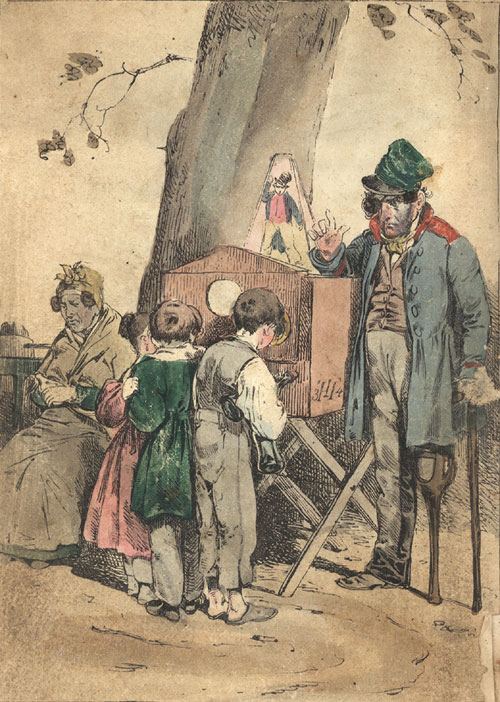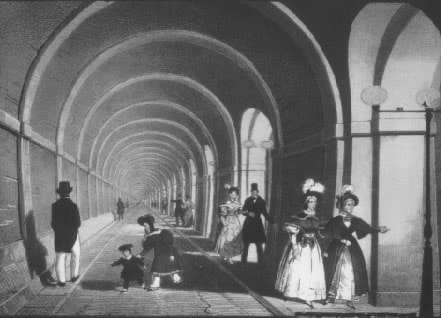
Photo: TypePunchMatrix
This post may contain affiliate links. If you make a purchase, My Modern Met may earn an affiliate commission. Please read our disclosure for more info.
Today, virtual reality technology involves putting on some sort of headset that can transform the world around you, from creating an immersive experience out of the Mona Lisa to seeing wilderness from the perspective of wildlife animals. But did you know there were similar experiences in the 19th century that could transport you across the world? A popular Reddit post has recently introduced many to the inventive art form that kept audiences entertained for centuries, known as paper peepshows. These paper crafts were used to mark historic events, like the Queen’s coronation, but can also be easily made at home.
What are paper peepshows?
Paper peepshows, also known as peek-a-boo books, peepshow books, and tunnel books, are a special form of immersive storytelling. They’re made up of several pages bound together by folded pieces of paper on each side. When folded out, these books are accordion-looking. Each page is carefully crafted with cutouts to reveal the page behind it, adding to the illusion of depth and perspective. The viewer looks through the small hole in the front, enveloping themselves in a tiny, three-dimensional scene that feels life-sized.
View this post on Instagram
Allie Alvis, a book collector and historian, shares an example of a tunnel book from 1830 that transports viewers to Paris for a quick promenade. The book’s incredibly illustrated five pages provide a glimpse at what outdoor social life looked like for Parisians at the time. Its three peepholes allow for multiple vantage points of some of Paris’ most iconic landmarks, like the Arc de Triomphe. Alvis’ find has been re-shared on Reddit, where many are amazed by the craftsmanship and ingenuity. If you’re able to spare $2,500, you can purchase it on Etsy.
View this post on Instagram
Where do paper peepshows come from?

Photo: Theodor Hosemann via Wikimedia Commons (Public domain)
Paper peepshows such as Alvis’ are successors of the sturdier peepshows made out of wood or cardboard from the 18th century. As the Victoria and Albert Museum describes, traveling peepshow men “would charge adults and children to look inside the box, while commenting on the scene depicted and bringing it to life.” Peepshows were inspired by the theatrical stage and their movable set pieces. Paper peepshows became popular a century later in Europe, when optical devices and spectacles were trendy. Both versions of the enchanting art form would often depict moments in everyday life or historical events in a colorful, busy, and action-packed way.
Why are paper peepshows also called tunnel books?

Photo: Nichtbesserwisser via Wikimedia Commons (Public domain)
A popular historical event in the 19th century that captivated a mass international audience was the building of the Tunnel Thames in London. Its construction lasted from 1825 to 1843, and its fame was captured in several forms of memorabilia, notably including paper peepshows. The Gestetner Collection has over 60 examples of the elaborate art form displaying the Tunnel Thames alone, hence its alternative name, tunnel book.
How to Make a Paper Peepshow
Many modern artists still use this art form today, such as Tara Bryan’s Down the Rabbit Hole, a transformation of Lewis Carroll’s Alice in Wonderland. Bryan’s piece is created using museum board, paper, thread, and fabric. Paper peepshows like this one can be easily created at home using cardstock, scissors, and glue. Other art supplies such as watercolors and pens can help make your piece some to life. Foxborough Art Pass provides the perfect template and directions for beginners wanting to explore this art form. The Victoria & Albert Museum in London has also created its own DIY tutorial with downloadable templates and instructions. For visual learners, Austin Parks & Recreation has an in-depth tutorial using printer paper to create a Bigfoot forest scene:
Related Articles:
15 Tissue Paper Flower Tutorials on How to Craft Your Own Beautiful Blooms
15 Fantastic Scrapbooking Ideas to Creatively Chronicle Your Life
30 Famous Paintings From Western Art History Any Art Lover Should Know
Interview: Artist Crafts Realistic Paper Bird Sculptures That Look Like Wildlife Photos
